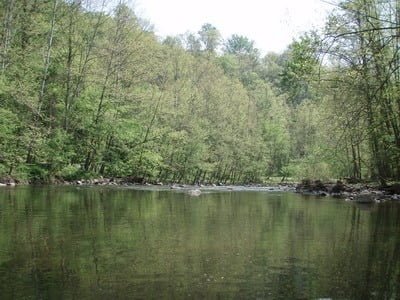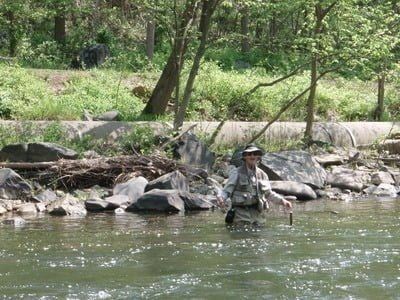In early May, Chuck and I made a beeline for the Patapsco River to fish the upper Avalon section. A few weeks earlier, it had been stocked with a good load of rainbow trout and this was a prime time to visit. Last year, I fished the lower Avalon later in the summer and, of course, did not pick up any trout and only saw a few smallies. Beyond trout season, it seems like this section of the river is only home to bluegills and chubbs.
With my previous experience tainting my perspective of this river, I was anxious to see how it would be at the height of trout season. On the way up, Chuck told me that Maryland only stocks trout up to the waterfall above the last parking lot on the western side. This confirmed my conclusion earlier in the year that it did not pay to do long hikes into remote areas where the only fish in the river were stockers. Sadly, you need to think like the stock truck. Unless the fish will be washed downstream or can migrate upstream, they will be localized where the stock truck can easily insert them into the river.
The Avalon section of the Patapsco is perfect for stocking. The road follows the west side of the river for several miles, making it easy to insert trout in many locations. On this day in early May, Chuck and I were the beneficiaries of this situation. We drove to the last parking lot on the west side, geared up and headed upstream to the waterfall. After walking about a half mile. I noticed that my rod tip had broken. Rats! I returned to the truck and got my backup rod and rejoined Chuck on the stream. This makes a good point; you should always have backup equipment because you never know when something like this will happen. Chuck had already started to work the fast water below the waterfall, a bit downstream, where the water bunches up on the rocks. He was already into the trout.
While we all enjoy fishing dry flies based on the excitement of the surface take, today would be a day for nymphing. Chuck was working a double woolly bugger rig with split shot and 4X Tippet. He was tight line nymphing these in the cuts and picking up fish. At my stage of fly-fishing maturity. I do not have the fine touch to do this. My approach was the standard indicator with a two-nymph rig dragging underneath. Instead of woolly buggers, I settled on a reddish-brown top nymph with a small copper john beneath it.
After I got warmed up, I started to pick up the fish as well. In fact, I was amazed at how close I could get to the trout and still catch them. Several of the runs that we visited were in fairly tight sections of the river. I would flip the indicator upstream, watch it drift down, and pick up trout within five to 10 feet of where I was standing. In one stretch, I picked up three trout out of the same hole – all within 5 feet of where I was standing. Wading carefully does pay off.
As you can see from the map, we worked the top section and then drove down and parked by the special regulation pond to hit one more stretch. This lower stretch was not as productive as the upper section. While we regularly caught fish in the top stretch, there was nothing in this lower portion. Why? Perhaps it’s closer to the larger parking lot and recreation area with the associated pressure. But maybe the key reason is that it’s a little bit farther from the road, making it harder for the stock truck to gain access. It’s still a pretty section to fish, and Chuck assured me it does see its fair share of stocking.
The Patapsco in the Avalon section is not the typical central Maryland trout water. Unlike Great Seneca Creek, the Middle Patuxent, or some of the other more hammered stocked waters like the Northwest Branch. It actually looks nice. The water runs downstream quickly with plenty of rocks throwing up some spray to give you a sense of remoteness. While we did see some other fishermen, we never felt pressured as those guys were mostly near the parking lot.

One aspect of the Avalon section is that it consolidates pressure near the parking lots since there are no turnoffs along the river. So, while the road may parallel the river for several miles, there’s no place to park other than the approved parking lots. In effect, you do get a trout hike here. Once you park in one of the few parking lots, you have to walk to hit the entire river. You can’t move from turnoff to turnoff and work the road like you can on some of the other water like the South Fork of the Piney in Virginia.
Patapsco River Trout Fishing Bottom line: This is a nice place to go as long as the fish are present. Sadly, this means that you have to watch the stocking table and pay attention to the trout stocking season. It’s a shame that Maryland does not stock smallmouth in this water as they would be happy to live here year-round and give us fish to pursue on a similar timetable.
Getting There: You will pay 2 bucks to get into the park.
The DNR has good directions:
“From I-95 – Take exit 47 and travel east on I-195. Take exit 3 to Elkridge. Turn right on U.S. 1, heading south. Take next right on South Street. Park entrance is on left.”
Secrets Revealed? No. This is a very public location that is documented in the following places:
Maryland DNR
Guide to Maryland Trout Fishing

Looking up at the waterfall that marks the end of the stocked section

Downstream from the waterfall. There are deep sections here.

Chuck with his first fish of the day

Typical riffle/rock section

Every bend turns into a deeper pool – many of these held trout the day we were here

This is where I picked up the trout standing right next to them. They were on the far bank in the riffle

Good current, clean water

Typical trout
Unless stated otherwise, this article was authored by Steve Moore


